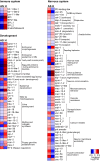Differential regulation of degradation and immune pathways underlies adaptation of the ectosymbiotic nematode Laxus oneistus to oxic-anoxic interfaces
- PMID: 35697683
- PMCID: PMC9192688
- DOI: 10.1038/s41598-022-13235-9
Differential regulation of degradation and immune pathways underlies adaptation of the ectosymbiotic nematode Laxus oneistus to oxic-anoxic interfaces
Abstract
Eukaryotes may experience oxygen deprivation under both physiological and pathological conditions. Because oxygen shortage leads to a reduction in cellular energy production, all eukaryotes studied so far conserve energy by suppressing their metabolism. However, the molecular physiology of animals that naturally and repeatedly experience anoxia is underexplored. One such animal is the marine nematode Laxus oneistus. It thrives, invariably coated by its sulfur-oxidizing symbiont Candidatus Thiosymbion oneisti, in anoxic sulfidic or hypoxic sand. Here, transcriptomics and proteomics showed that, whether in anoxia or not, L. oneistus mostly expressed genes involved in ubiquitination, energy generation, oxidative stress response, immune response, development, and translation. Importantly, ubiquitination genes were also highly expressed when the nematode was subjected to anoxic sulfidic conditions, together with genes involved in autophagy, detoxification and ribosome biogenesis. We hypothesize that these degradation pathways were induced to recycle damaged cellular components (mitochondria) and misfolded proteins into nutrients. Remarkably, when L. oneistus was subjected to anoxic sulfidic conditions, lectin and mucin genes were also upregulated, potentially to promote the attachment of its thiotrophic symbiont. Furthermore, the nematode appeared to survive oxygen deprivation by using an alternative electron carrier (rhodoquinone) and acceptor (fumarate), to rewire the electron transfer chain. On the other hand, under hypoxia, genes involved in costly processes (e.g., amino acid biosynthesis, development, feeding, mating) were upregulated, together with the worm's Toll-like innate immunity pathway and several immune effectors (e.g., bactericidal/permeability-increasing proteins, fungicides). In conclusion, we hypothesize that, in anoxic sulfidic sand, L. oneistus upregulates degradation processes, rewires the oxidative phosphorylation and reinforces its coat of bacterial sulfur-oxidizers. In upper sand layers, instead, it appears to produce broad-range antimicrobials and to exploit oxygen for biosynthesis and development.
© 2022. The Author(s).
Conflict of interest statement
The authors declare no competing interests.
Figures







Similar articles
-
Anaerobic Sulfur Oxidation Underlies Adaptation of a Chemosynthetic Symbiont to Oxic-Anoxic Interfaces.mSystems. 2021 Jun 29;6(3):e0118620. doi: 10.1128/mSystems.01186-20. Epub 2021 May 26. mSystems. 2021. PMID: 34058098 Free PMC article.
-
Sequence variability of the pattern recognition receptor Mermaid mediates specificity of marine nematode symbioses.ISME J. 2011 Jun;5(6):986-98. doi: 10.1038/ismej.2010.198. Epub 2011 Jan 13. ISME J. 2011. PMID: 21228893 Free PMC article.
-
The Longitudinal Dividing Bacterium Candidatus Thiosymbion Oneisti Has a Natural Temperature-Sensitive FtsZ Protein with Low GTPase Activity.Int J Mol Sci. 2022 Mar 10;23(6):3016. doi: 10.3390/ijms23063016. Int J Mol Sci. 2022. PMID: 35328438 Free PMC article.
-
Mitochondrial adaptations to utilize hydrogen sulfide for energy and signaling.J Comp Physiol B. 2012 Oct;182(7):881-97. doi: 10.1007/s00360-012-0654-y. Epub 2012 Mar 20. J Comp Physiol B. 2012. PMID: 22430869 Review.
-
Tolerance of roots to low oxygen: 'Anoxic' cores, the phytoglobin-nitric oxide cycle, and energy or oxygen sensing.J Plant Physiol. 2019 Aug;239:92-108. doi: 10.1016/j.jplph.2019.04.010. Epub 2019 Apr 26. J Plant Physiol. 2019. PMID: 31255944 Review.
Cited by
-
The role of glycoconjugates as receptors for insecticidal proteins.FEMS Microbiol Rev. 2023 Jul 5;47(4):fuad026. doi: 10.1093/femsre/fuad026. FEMS Microbiol Rev. 2023. PMID: 37279443 Free PMC article. Review.
References
Publication types
MeSH terms
Substances
Grants and funding
LinkOut - more resources
Full Text Sources
Molecular Biology Databases

